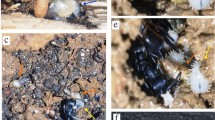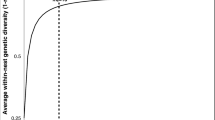Abstract
Two to eight females of a neotropical, primitively social wasp, Auplopus semialatus(Pompilidae), cooperatively build and maintain mud nests. Females capture non-web-building spiders as provisions for their offspring. Cohabiting females are usually tolerant of one another and defend the nest against natural enemies, including the cleptoparasitic wasp, Irenangelus eberhardi(Pompilidae). They often become intensely competitive, however, when a spider is brought to the nest. Auplopusfemales steal spiders from both uncapped and newly capped cells and eat the previous owner's egg. Many observations highlight the primitive level of sociality in this species, and the discussion relates these observations to those based on other primitively social wasps.
Similar content being viewed by others
References
Abrams, J., and Eickwort, G. C. (1981). Nest switching and guarding by the communal sweat beeAgapostemon virescens (Hymenoptera, Halictidae).Insectes Soc. 28: 105–116.
Alcock, J., and Buchmann, S. L. (1985). The significance of post-insemination display by maleCentris pallida (Hymenoptera: Anthophoridae).Z. Tierpsychol. 68: 231–243.
Alexander, B., and Rozen, J. G., Jr. (1987). Ovaries, ovarioles, and oocytes in parasitic bees (Hymenoptera: Apoidea).Pan.-Pac. Entomol. 63: 155–164.
Alexander, R. D. (1974). The evolution of social behavior.Annu. Rev. Ecol. Syst. 5: 325–383.
Eberhard, W. G. (1974). The natural history and behaviour of the waspTrigonopsis cameronii Kohl (Sphecidae).Trans. R. Entomol. Soc. Lond. 125: 295–328.
Evans, H. E. (1969). Studies on neotropical Pompilidae (Hymenoptera). VII.Irenangelus Schulz.Stud. Entomol. 12: 412–431.
Evans, H. E. (1973). Studies on Neotropical Pompilidae (Hymenoptera), IX. The genera of Auplopodini.Psyche 81: 212–226.
Evans, H. E. (1987). A new species ofIrenangelus from Costa Rica (Hymenoptera, Pompilidae, Ceropalinae).Proc. Entomol. Soc. Wash. 89: 559–561.
Evans, H. E., and Hook, A. W. (1986). Nesting behavior of AustralianCerceris digger wasps, with special reference to nest reutilization and nest sharing.Sociobiology 11: 275–302.
Evans, H. E., and Matthews, R. E. (1973). Behavioural observations on some Australian spider wasps (Hymenoptera: Pompilidae).Trans. R. Entomol. Soc. Lond. 125: 45–55.
Evans, H. E., and West-Eberhard, M. J. (1970).The Wasps, University of Michigan Press, Ann Arbor.
Ferton, Ch. (1923).La Vie des Abeilles et des Guêpes, E. Chiron, Paris.
Iwata, H. (1976).Evolution of Instinct, Prm. Printing Press, Lucknow, India.
Kimsey, L. S. (1980). Notes on the biology of some Panamanian Pompilidae, with a description of a communal nest (Hymenoptera).Pan.-Pac. Entomol. 56: 98–100.
Lin, N. (1964). Increased parasitic pressure as a major factor in the evolution of social behavior in halictine bees.Insectes Soc. 11: 187–192.
Lin, N., and Michener, C. D. (1972). Evolution of sociality in insects.Q. Rev. Biol. 47: 131–159.
Michener, C. D. (1985). From solitary to eusocial: Need there be series of intervening species?Fonschr. Zool. 31: 293–305.
Olberg, G. (1959).Das Verhalten der Solitären Wespen Mitteleuropas (Vespidae, Pompilidae, Sphecidae), Deutscher Verlag Wissenschaften, Berlin.
Rau, P. (1928). Field studies in the behavior of the non-social wasps.Trans. Acad. Sci. St. Louis 25: 1–489.
Richards, O. W., and Hamm, A. H. (1939). The biology of the British Pompilidae (Hymenoptera).Trans. Soc. Br. Entomol. 6: 51–114.
Smith, D. T. (1982). Reproductive success of solitary and communalPhiloponella oweni (Araneae: Uloboridae)Behav. Ecol. Sociobiol. 11: 249–256.
Sullivan, J. D., and Strassman, J. E. (1984). Physical variability among nest foundresses in the polygynous social wasp,Polistes annularis.Behav. Ecol. Sodobiol. 15: 249–256.
Wcislo, W. T. (1987). The roles of seasonality, host synchrony, and behaviour in the evolutions and distributions of nest parasites in Hymenoptera (Insecta), with special reference to bees (Apoidea).Biol. Rev. 62: 515–543.
West-Eberhard, M. J. (1979). Sexual selection, social competition, and evolution.Proc. Am. Phil. Soc. 123: 222–234.
West-Eberhard, M. J. (1987). Flexible strategy and social evolution. In Itô, Y., Brown, J. L., and Kikkawa, J. (eds.),Animal Societies: Theories and Facts, Japan Scientific Societies, Tokyo, pp. 35–51.
Wheeler, D. E. (1986). Developmental and physiological determinants of caste in social Hymenoptera: Evolutionary implications.Am. Nat. 128: 13–34.
Williams, F. X. (1919). Philippine wasp studies. II. Descriptions of new species and life history studies.Bull. Exp. Stat. Haw. Sug. Plant. Assoc. (Entomol. Ser.) 14: 19–186.
Wilson, E. O. (1971).The Insect Societies, Harvard University Press, Cambridge, Mass.
Author information
Authors and Affiliations
Rights and permissions
About this article
Cite this article
Wcislo, W.T., West-Eberhard, M.J. & Eberhard, W.G. Natural history and behavior of a primitively social wasp,Auplopus semialatus, and its parasite,Irenangelus eberhardi (Hymenoptera: Pompilidae). J Insect Behav 1, 247–260 (1988). https://doi.org/10.1007/BF01054524
Accepted:
Issue Date:
DOI: https://doi.org/10.1007/BF01054524




